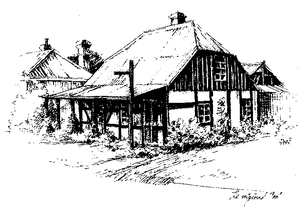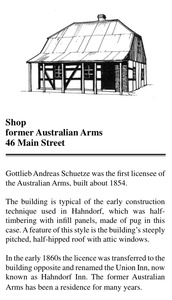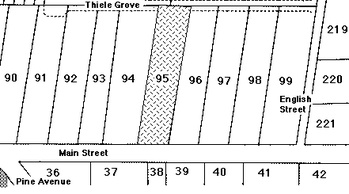This Page forms part of the overall Zebra-ProjectBy clicking on the following Link a list of all Zebra-Project tabbed pages will be displayed. |
To return to : Lothar BRASSE Summary
 From 'Historic Australian Towns'
From 'Historic Australian Towns'
Photographs by author 11 March 2024
 |
 |
 |
 |
 |
|
Information about Gottlieb Andreas SCHÜTZE & his wife Maria Dorathea ROEDRIGER
Gottlieb Andreas SCHÜTZE:
- Father: Gottfried Christoph Andreas SCHÜTZE b1779 Egern, Kochstedt, Salzlandkreis, Sachsen-Anhalt, Prussia. At 54 years d 3.5.1871 Blumberg, South Australia.
- Mother: Christiane Elisabeth NIEWERTH 19.11.1781, Sachsen, which is SE of Magdeburg, Germany.
- Married: 2.1.1841 Hackpfüffel, Sangerhausen, Sachsen-Anhalt, Prussia.
- Wife: Maria Dorathea ROEDRIGER b14.3.1818, Hackpfüffel, Sangerhausen, Sachsen-Anhalt. At 75 years d 4.1.1894 Mannum, South Australia, buried Mannum Cemetery.
Arrived in South Australia: Ships List Wilhelmina Maria, arrived Port Adelaide 30 August 1849.
| Schuetze | Gottlieb Andreas | 32 | Publican | 1447/2 | Germany | |
| Maria Dorethea (Roedriger) | 31 | |||||
| Gottlieb Wilhelm | 6 | |||||
| Friedrich Eduard | 2 | |||||
| Carl Friedrich | 1 | |||||
-
Children:
- Gottlieb Wilhelm 1843-1922, married Mary Ann HUDSON in 1879.
- Friedrich Eduard 1847-1939, married Minni BUERMAN in 1879.
- Carl Friedrich died 1907 Mannum
- Maria Dorothea b 26.11.1849 'Nr the Companys Mill'
- Maria Caroline b1853 Hahndorf, married WILKE.
- Louisa Rosalie b1855.
- Adolph Theordor [sic] b1859 Hahndorf.
Hahndorf State Heritage Area, Department of Environment and Natural Resources, page 4
'Gottlieb Andreas SCHUETZE was the first licensee of the Australian Arms, built about 1854. The building is typical of the early construction technique used in Hahndorf, which was half timbering with infill panels, made of pug in this case. A feature of this styles the building's steeply pitched, half hipped roof with attic windows. In the early 1860's the licence was transferred to the Union Inn, now known as the Hahndorf Inn. The former Australian Arms has been a resident for many years. '
In 1857 a trial in the Supreme Court brought by the sons in law of Gottfried LUBASCH against his youngest daughter Maria Elizabeth LUBASCH regarding the validity of her father's will was reported at length in many of the newspapers. The testimony of one of the witnesses, Johann Gottfried DOLLING described a meeting at the Australian Arms at 46 Main St, Hahndorf, between Gottfried LUBASCH and Gottlieb SCHUETZE [SCHÜTZE]. I note that the surname is incorrectly spelt [SCHULTZE] in the newspaper.
"The Attorney-General called the following witnesses, to show the state of the deceased's mind on the Saturday before his death.
Johann Gottfried DOLLING — Knew the deceased 20 years previous to his death. Saw him 11 hours before he died. Shook bands with him, and remarked to him, "We only met on Tuesday, and you have been taken suddenly ill". LUBASCH replied, "After you left me, I was passing by Mr. SCHULTZE's public-house, and he asked me to go in. I went in, and said I was not in a state to drink. SCHULTZE replied that he did not ask me in to drink, but that Mrs. SCHULTZE would make me a cup of coffee". He then went on to state that he 'remained to tea ; and a good deal more conversation passed between witness and LUBASCH, which he could not recollect. Remained about an hour and a half. LUBASCH made his statements with perfect composure. This was between 6 and 9 o'clock in the evening."
---------------------------------------------------------------------------------------------------------------------------------------------------
LOCATION: 44-46 Main Street, Hahndorf
SHR 10510 – 46 Main Street confirmed as a State Heritage Place 24 July 1980
The Australian Arms hotel was built in 1854 by Gottlieb Andreas Schuetze in the fachwerk style with a steep pitched roof. In 1863 the licence was transferred to the larger building opposite and renamed the Union Inn (now known as Hahndorf Inn). This building, which after the hotel relocation, had been a residence for many years and is currently a leather business, has a steeply pitched half-roof, with attic windows. It is typical of the early German building style used in Hahndorf, being red gum half-timbering, with wattle and daub infill panels. In the 1960's the owner demolished half of this fachwerk building to widen the driveway to his petrol station.
Refer to Hahndorf Inn for history of the hotel after it was located on the opposite side of the Main Road.
Brief History
Extract from 'Hahndorf - A Journey through the Village and its History', by Anni Luur Fox (2002)
 Like its rival, the German Arms, this hotel was first established across the road from its present site. My small drawing shows the portion of the original fachwerk hotel at No. 44 that escaped demolition after Mr. Walkom became the owner in 1953. Half of the building was sacrificed to widen the driveway to the petrol station. Gottlieb Schuetze had bought this allottment on 29 August 1853 from the first Lutheran settler, Samuel Bartsch, a joiner who had moved to Gruenberg in the Barossa Valley. Schuetze had registered his new hotel as “The Australian Arms” in 1854, a period which coincided with the completion of the Great Eastern Road from Adelaide to Paterson’s, just past the windmill. After discovery of gold at Echunga in August 1852, the district had been swarming with thirsty gold-diggers as well as the adventurous souls who stopped to refresh themselves in Hahndorf on their way to the rich goldfields of Victoria. In 1858 Hahndorf’s own minor gold rush also increased its population of miners hoping for a lucky strike.
Like its rival, the German Arms, this hotel was first established across the road from its present site. My small drawing shows the portion of the original fachwerk hotel at No. 44 that escaped demolition after Mr. Walkom became the owner in 1953. Half of the building was sacrificed to widen the driveway to the petrol station. Gottlieb Schuetze had bought this allottment on 29 August 1853 from the first Lutheran settler, Samuel Bartsch, a joiner who had moved to Gruenberg in the Barossa Valley. Schuetze had registered his new hotel as “The Australian Arms” in 1854, a period which coincided with the completion of the Great Eastern Road from Adelaide to Paterson’s, just past the windmill. After discovery of gold at Echunga in August 1852, the district had been swarming with thirsty gold-diggers as well as the adventurous souls who stopped to refresh themselves in Hahndorf on their way to the rich goldfields of Victoria. In 1858 Hahndorf’s own minor gold rush also increased its population of miners hoping for a lucky strike.
A good townsman active in community affairs, Schuetze became chairman of a committee in charge of building the new St. Michael’s Lutheran Church. Hahndorf’s religious community was well versed in the culture of the grape. Amongst Pastor Kavel’s list of advice for retaining health during the long voyage to Australia had been to bring sufficient wine or brandy for “a nobbler a day.” The Zebra had carried one hogshead of wine, 50 bottles of cognac, 105 bottles of port and 25 bottles of bitter brandy. Hahndorf’s settlers were amongst the first in the colony to cultivate grape vines. Almost every home had a few vines to make a Hock-like wine which was drunk as if it was tea. There was no minimum drinking age for spirits until 1863, but children under twelve years could still be served wine or beer in the colony’s hotels until 1880.
The Australian Arms was the birthplace of the Hahndorf Institute on 21 October 1861. A few days later, the committee accepted Miller Wittwer’s offer of the use of a front room at his new residence opposite his steam mill until money could be raised for a separate Institute building. The hotel became a regular place for dinner following lectures on learned subjects at the Institute. These occasions usually finished very late at night requiring patrons to find their way home from the pub by lantern or, if the wine had been particularly good, astride a horse that needed no human hand to guide it in the right direction.
Wishing to transfer his hotel to a single storey building over the road at No. 35, in December 1863, Mr Schuetze sold No. 46 to Friedrich Wilhelm Bremer. He was a tailor whose habit of sitting cross-legged on the bar while hand-stitching garments must have imprinted itself on the minds of villagers sufficiently well to be handed on in family stories. His son, Alfred Hieronymous, was born that year. Alfred became a well-known wheelwright and coachbuilder who lived in the former hotel and operated his business on the site of the current petrol station next door. From 1869 he shared the workshop with C.W. Haehnel and Co. Australian Photographic Company which advertised “Portraits Taken in any Weather.” Edmund Diederich worked for this company after he arrived in 1881. Upon acquiring a studio on wheels, he and his wife and daughter travelled throughout South Australia taking photographs which have provided us with a superb record of late 19th Century life. They settled back in Hahndorf in a small slab cottage on Tischer Road where I visited his daughter Ida Scharenburg in the 1970’s for permission to use her father’s photographs in my first book. A section of ceiling had collapsed revealing a wonderful store of glass photographic plates which she kindly allowed me to reproduce.
Alfred Bremer’s sideline was carving wooden horses for merry-go-rounds. Like his neighbour Carl Bom, he was active in the rifle club and probably enjoyed his friends’ company in Schuetze’s new premises across the road where his father was publican in 1872. Alfred’s wife Emma (nee Gallasch) gave birth to a son in 1896. Percy grew up to earn his living as a painter of horse-drawn carriages. Having taken lessons from Hans Heysen he later turned his considerable talents to become an artist. .....
Early Ownership
Information from The Hahndorf Allotments Database compiled by Reg Butler.
| Old Lot No. | New Lot No. | Street No. | Street Name |
| House 35 | N.H. 95 | 44 | Main Street |
| Year Sold | New Owner | Occupation | Owner's Home | Personal |
| 1839 | Samuel Bartsch # | joiner | Hahndorf | From Skampe, Brandenburg. |
| 1853 | Gottlieb Schuetze * | carpenter | Hahndorf | GRO title. |
| 1855 | James Owen | licensed victualler | Kensington | |
| 1863 | Wilhelm Bremer | tailor | Hahndorf | |
| 1889 | Johanna Bremer | widow of W Bremer | Hahndorf | |
| 1911 | Alfred Bremer ** | wheelwright | Hahndorf | Son of W & J Bremer. |
| 1949 | Percy Bremer | gentleman | Hahndorf | Son of A Bremer. |
| 1963 | Roy Walkom % | motor engineer | Hahndorf | |
| Sub-Lot 1 - 44 Main Street, Hahndorf | ||||
| 1969 | Laurence Munro | driver | Hahndorf | |
| 1974 | Norman Crittenden | garage proprietor | Hahndorf | |
| 1979 |
Ernest Cambridge Phyllis Cambridge Mark Cambridge Anne Cambridge |
general agent operator general agent secretary |
Mt Barker Mt Barker Mt Barker Mt Barker |
|
Notes:
% R Walkom divided NH 95 into two Sub-lots in 1969. Filed plan 160 shows the boundary between the main street and Thiele Grove portion of the Lot.
Sub-lot 1 44 Main St; 3609/165 current title
Sub-lot 2 44A Main St; 11 Thiele Grove 4150/404 current title
# S Bartsch had moved to Grünberg in the Barossa Valley before official land transfers began in Hahndorf.
* G Schuetze established the 'Australian Arms' on this site. It later became a private home only when the hotel business crossed the main street c1863. W Bremer conducted his tailor business from the house.
** A Bremer established his wheelwright shop on this site, next to his home.
Although Lot NH 95 is on two separate titles, the same owners have possessed the whole piece of land since 1974.
3609/165 current title.
4150/404 Metric title
Early Publicans
Australian Arms - Information from Reg Butler
- SCHUETZE, Gottlieb Andreas 1854-1855, 1857-1861
- OWEN, James 1855-1856
- ANDERSON, William 1856-1857
- SCHUNKE, George 1861-1863




